Optional practical training (OPT) allows international students to pursue post-study work in the US. It lets them stay for a year to gain relevant experience and build a solid foundation for their career through various US work opportunities. But what happens after OPT? After OPT, students are given a 60-day grace period to either obtain an extension, change their visa status, enrol in another academic program or leave the country. In this guide, we break down these options for international students with expiring OPT permissions.
What is OPT?
OPT is a temporary work permission granted to eligible enrollees on F-1 student visas. It permits international students to take a paid job that’s directly related to their major or area of study. Through OPT, international students can remain in the US for up to 12 months.
Students can apply for OPT at each education level, but these periods of work may not overlap. This means that a student can do OPT after they finish their undergraduate program, and then again after they finish their postgraduate studies.
Students may take OPT before (pre-completion OPT) or after (post-completion OPT) they graduate. They may also do both, but the time that would be granted for post-completion OPT shall be reduced based on the period of work they’ve already rendered during pre-completion OPT.
How long can international students stay in the US after OPT?
Working on a US student visa is temporary. Once an international student’s OPT expires, they are granted a 60-day grace period. At this time, they must take the appropriate steps to legally remain in the US or promptly leave the country.
Students who stay in the US past the end of the grace period without transferring to a new school or program, changing their visa status or leaving the country will effectively violate their F-1 visa. This could lead to current or future consequences on their US visa record which may affect future immigration opportunities in other countries, as well.
What international students can do after OPT
International students have several pathways that they can choose before their OPT expires. Let’s explore each one.
Extend OPT
International students who have earned a degree in certain STEM (Science, Technology, Engineering and Mathematics) fields may extend their post-completion OPT for another 24 months. This would allow them to remain and work in the US for three years.
The STEM OPT extension is available to students who:
- have received a STEM degree listed in the STEM Designated Degree Program
- are currently working under post-completion OPT, having received an initiation grant of post-completion OPT authorisation based on their STEM degree
- are employed by (or wish to work with) a company that uses the E-Verify program
- have a signed Form I-983 (“Training Plan for STEM OPT Students”).
Change visa status
International students who wish to continue working in the US may secure the appropriate work authorisation and change their visa status. This allows them to legally maintain their jobs and legal standing in the country. Here are a few pathways to consider:
H-1B visa for specialty workers
The H1-B visa is a temporary worker visa granted to individuals in specialty occupations, i.e. those that require highly specialised knowledge. This visa can last up to six years.
To qualify for an H-1B visa, a candidate must hold at least a bachelor’s degree or advanced certification and find an employer willing to sponsor their petition.
Getting an H-1B visa is an intricate process and should begin several months before a student’s OPT expires.
O-1 visa for individuals with extraordinary ability
The O-1 visa is for people who possess extraordinary ability in the sciences, arts, education, business or athletics. It’s also available to those who have a demonstrated record of achievement in the movie or TV industry and have been recognised nationally or internationally for those achievements.
E-2 visa for treaty investors
The E-2 visa is given to citizens of treaty countries who make significant investments in US companies. This entry permission is extendable to spouses and children – and even certain employees – who apply as dependants of the primary visa holder. Investors with an E-2 visa may also establish and manage businesses in the US.
J-1 visa
The J-1 visa is an authorisation granted to exchange visitors who are participating in an approved program for:
- teaching
- instructing or lecturing
- studying
- observing
- conducting research
- consulting
- demonstrating special skills
- receiving training
- receiving graduate medical education or training.
It’s typically issued to professors, researchers or exchange students. It also requires sponsorship by an academic institution, government entity or private business under an exchange program approved by the US Department of State.
The J-1 visa program is designed to promote the interchange of person, knowledge and skills in education, arts and science.
Green card
A green card permits permanent residency in the US. This permission may allow international students to remain in the country and work for any US company indefinitely. That said, applying for a green card is a lengthy process that takes at least one year. And while it’s done, candidates must be on an appropriate work authorisation or visa.
Return to school
International students who finish their OPT may take another academic program, either in the same institution or another. However, they may only start a part-time course while on OPT. Otherwise, they must forfeit the remainder of their OPT before they begin studying.
Further education is a viable option for those who want to enhance their skills and advance their career opportunities. Moreover, another program may open up renewed work placements – through curriculum practical training (CPT) or another OPT program (if the student is pursuing a different education level). Advanced programs also typically offer higher quotas for H-1B visas, increasing the likelihood of obtaining employment sponsorship after graduation.
Depart the US
International students who believe that they have maximised their US education and post-study work opportunities may decide to return home. This is an ideal step for those who hope to bring the value of their learnings back to their own country.
Students departing the US must complete their work by the end date on their Employment Authorisation Document (EAD) and leave the country within the 60-day grace period after their OPT expires.
Post-OPT guidance from upGrad GSP
Navigating post-study work in the US can be challenging. However, our business development experts are ready to help our recruitment partners guide students to best take advantage of these career-enriching opportunities. Get in touch with us today to know more about what happens after OPT.




